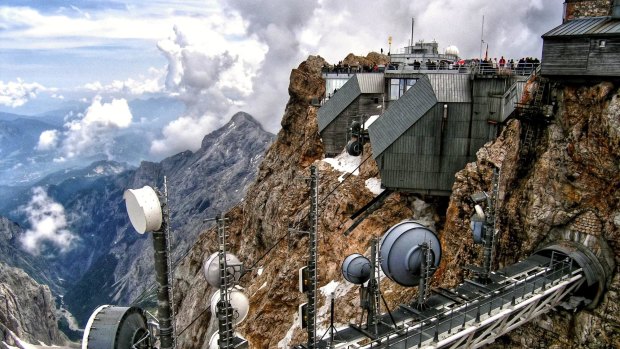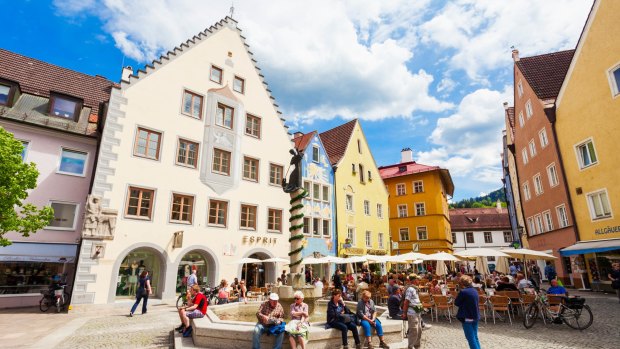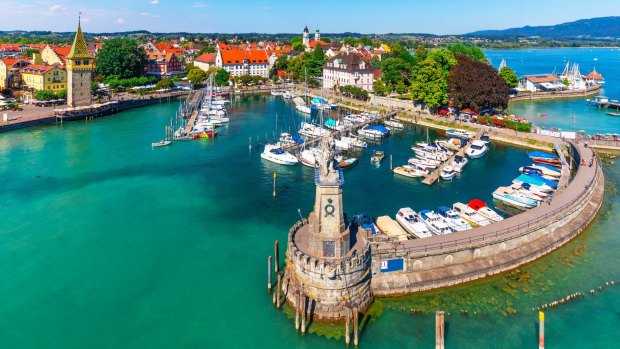This was published 5 years ago
Road trip, Germany: Bavaria's Alpine Road has fairytale castles, mountains, lakes and beer halls

The Zugspitze, at 2962 m above sea level, is the highest peak in Germany. It lies south of the town of Garmisch-Partenkirchen, and the Austria-Germany border runs over its western summit. Credit: SHUTTERSTOCK
The Alpine Road starts with a bang, but certainly doesn't end with a whimper. It begins in the east at dramatic Lake Königssee among high mountains, and finishes in the west at Lindau, whose old town juts into Lake Constance like an opera box onto a glorious stage set of distant snow peaks. If you're wondering what music to listen to as you drive the 450 kilometres in between, choose something grandiose and stirring. Wagner, perhaps, swirling to crescendos on the car loudspeakers as you traverse landscapes fit for legend.
God got carried away when he created the Bavarian Alps, and yet the Bavarians weren't quite satisfied with the almighty's saccharine splendours. Over the centuries they added baroque abbeys, mad castles, churches with popping onion domes, and houses painted with rural scenes. They took to wearing dirndls, drinking beer, cranking up the oompah bands and tucking into gigantic pork knuckles. The whole Alpine Road is impossibly pretty and kitsch.
There's so much to see, you should consider taking a week to drive the route. Providing you have confidence with mountain bends, it presents no great challenge other than craftily concealed speed cameras and occasional lumbering tourist coaches. Sections, especially towards the eastern end, are actually surprisingly coach free, with more German than international visitors and perhaps even better landscapes.

Colorful houses in the Fussen old town city centre.Credit: SHUTTERSTOCK
You could access the Alpine Road from Munich, though at its eastern end Salzburg is much closer and adds another dollop of delight. (Zurich is also an easy access point if you're driving the route in the opposite direction.) Start at Berchtesgaden, a vertical piece of Germany wedged amid Austrian mountains and best known for Hitler's Eagle's Nest alpine retreat. Königssee is the highlight. The emerald-coloured lake has a fiord-like quality. The horns of sightseeing boats echo mournfully around its cliffs. Hike up to Malerwinkel for a panorama much painted by enraptured German artists.
Berchtesgaden was established as a salt-mining centre. You can descend into an old mine in a little train and cross an eerie black underground lake in a wooden boat, as if you're embarking on a journey to the furthest reaches of hell. Back outside, you'll be dazzled by sunlight and assaulted by visions of paradise in the form of alps, flowery meadows and tumbling streams.
From here the Alpine Road plunges down the mountains and skirts Lake Chiemsee, a popular destination among weekending urban Germans, but not the main game on the Alpine Road – not even for its island Herrenchiemsee Palace, King Ludwig II's rather predictable and overblown mirror-and-gold answer to Versailles. Press onwards, because there's plenty better to come. Lake Tegernsee is lovely, tucked right against the foothills of the Alps and offering kilometres of flower-decked lakeshore promenades that skirt between smart villas and swan-paddled water.

Scenic summer aerial view of the Old Town pier in Lindau, Bodensee.Credit: SHUTTERSTOCK
Stretch your car legs with a hike up the Grosses Paraplui and you'll see an alpine panorama impressive enough to have been showcased to an Austrian emperor and Russian tsar. Reward yourself afterwards in one of Germany's oldest breweries, the monk-founded Herzogliches Bräustüberl on the lake. Huge tankards of beer and Frisbee-sized schnitzels would be enough to satisfy an ogre.
Bavaria was independent until 1918 and retains a distinct, more jovial character than the rest of Germany. As you drive further west you head into Bavaria's traditional heartland of geranium-draped chalets, frescoed houses, swooning baroque cherubs and locals clad in lederhosen. Riverside spa town Bad Tölz is one of its prettiest incarnations. Some 60 kilometres down the road via another stunning alpine lake (Walchensee) is another, Mittenwald, notable for its long history of violin making.
Garmisch-Partenkirchen is the Alpine Road's biggest town and something of a concrete sprawl, but a good place to settle in for a few days if you want to hike or bike some of its 300 kilometres of trails. Various ski lifts will hoist you on high without effort, straight into stirring scenery above the tree line. A rack railway hauls you to the 2966-metre summit of Zugspitze, Germany's highest mountain.
Head onwards and you find yourself in Oberammergau, whose houses are painted with scenes from history and of hearty alpine peasants threshing wheat and herding cows. Shops are crammed with woodcarvings. The village is best known for its once-in-a-decade season of the Passion Play which runs in 2020 from May to October. The religious drama – which last an entire day – was first staged in 1634 in thanksgiving for the villagers' deliverance from the plague, and now involve a local cast of many hundreds.
The Passion Play has made Oberammergau famous, but more interesting is Füssen, which is rather overlooked despite its sitting almost in the shadow of Neuschwanstein Castle. Medieval north-south trading routes across the Alps made Füssen wealthy. The result is an impressive collection of monasteries and grand merchant mansions, topped by a bishop's castle and encircled by fortifications.
The Alpine Road bisects with the Romantic Road in Füssen, a mighty temptation to veer northwards on another tourist driving route. True, the 104 kilometres left of the Romantic Road from here onwards now reveals only minor cultural sights, but the countryside, where the Alps collapse into rolling hills and vineyards, is as beautiful as ever.
Lake Constance is a culminating pleasure. The lake is shared between Germany and Switzerland – plus a sliver of Austria – and is one of Europe's most charming corners, though scarcely known beyond the German-speaking world.
Lindau, the official end of the Alpine Road, is its highlight. Its old town sits on an island connected to the shore by bridges. It has the proud buildings and gravitas of a former free imperial town, and a Bavarian liveliness of beer halls and cafes in the shadow of gothic arches. In late afternoon, its lake walls are a grandstand onto the serrated snows of the Austrian and Swiss Alps across the water.
This driving route ends not with a whimper, but a full symphony for the soul.
KING LUDWIG'S PALACES
STAR-STUDDED
The romantic corner of Bavaria associated with King Ludwig II – a handsome and eccentric young monarch who was declared insane and deposed in 1886 – sits towards the western end of the Alpine Road near Füssen. Born in 1845, Ludwig spent most of his childhood at Hohenschwangau Castle, which is still owned by Bavaria's former royal family. Its yellow turrets rise above Lake Alpsee and the dark forested mountains of the Tyrolean Alps. The interior is more country house than castle but showcases the magnificent alpine setting and many of the design elements that would influence Ludwig in later life, including a medieval-style banqueting hall, oriental room and star-studded ceilings. See hohenschwangau.de
ROMANTIC EXTRAVAGANZA
Ludwig II's most famous creation is Neuschwanstein which clings to a crag above Hohenschwangau and seems rather modest viewed from below. Up close, the vast white building looms with turrets, towers and faux battlements. Don't miss the view of this romantic extravaganza set against the Alps from Marien Bridge, which spans a narrow gorge behind the castle. Neuschwanstein is by far the busiest attraction on the Alpine Road. Expect to jostle on the bridge for your selfie and queue to see the castle interior, which is swathed in emblems of Germanic and Wagnerian legends, red dragons, swans and other royal obsessions that culminate in a stunning (though rather theatrical) Byzantine-style throne room whose mosaic floors depict animals and trees. See neuschwanstein.de
BAROQUE BAVARIA
Also on the Alpine Road is Linderhof, outside Oberammergau. The little baroque palace only has 10 rooms but makes up for its petite size with an opulent, cherub- and gilt-encrusted decor. It isn't to everyone's taste, but its gardens are magnificent. Formal French parterres and Italian terraces give way to English landscapes that fade into forest. A Moorish pavilion and an artificial cave, complete with lake and shell-shaped boat, provide yet more examples of Ludwig II's whimsical imagination. See schlosslinderhof.de
TRIP NOTES
The writer travelled courtesy the German National Tourist Office and Leading Hotels of the World.
MORE
FLY
Etihad flies to Abu Dhabi with connections to Munich . See etihad.com
STAY
Althoff Seehotel Überfahrt, on Lake Tegernsee, has a spa, Michelin-starred restaurant and views. Further west, Schloss Elmau has spas and restaurants, a kids' club and a concert hall. Both are members of Leading Hotels of the World. See lhw.com
Sign up for the Traveller Deals newsletter
Get exclusive travel deals delivered straight to your inbox. Sign up now.